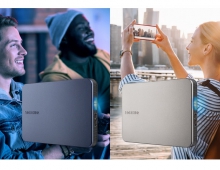
Toshiba Introduces New Multi-touch Technology
At Embedded World Toshiba Electronics Europe previewed a new technology that is set to broaden the spread of multi-point touchscreens in industrial and medical applications.
The company demonstrated a system that uses patent-pending algorithm to
combine the benefits of resistive and capacitive touch sensors while
overcoming limitations associated with each of these technologies.
Smartphones generally employ capacitive touchscreens that can recognise dual-touch gestures, such as pinch/zoom, but are unable to function with a pen, stylus or gloved hand. Resistive touchscreens, conversely, can accept pen, stylus and gloved inputs but do not typically support multi-touch. Resistive touchscreens cost significantly less than their capacitive equivalents, a factor that is particularly significant if touch technology is to migrate from its current bastion in high value portable consumer devices to the more cost-sensitive industrial marketplace.
Toshiba's demonstration showed a resistive touchscreen that, as well as accepting the usual pen, stylus and gloved inputs, can also interpret multi-touch gestures. The Resistive Touch Technology Demonstrator comprised an ARM9 development board front end for the touchpad and display coupled with an add-on PCB that amplifies the touch stimulus and calculates position and movement.
The technology is currently under development within Toshiba and it is planned for introduction later in the year.
Smartphones generally employ capacitive touchscreens that can recognise dual-touch gestures, such as pinch/zoom, but are unable to function with a pen, stylus or gloved hand. Resistive touchscreens, conversely, can accept pen, stylus and gloved inputs but do not typically support multi-touch. Resistive touchscreens cost significantly less than their capacitive equivalents, a factor that is particularly significant if touch technology is to migrate from its current bastion in high value portable consumer devices to the more cost-sensitive industrial marketplace.
Toshiba's demonstration showed a resistive touchscreen that, as well as accepting the usual pen, stylus and gloved inputs, can also interpret multi-touch gestures. The Resistive Touch Technology Demonstrator comprised an ARM9 development board front end for the touchpad and display coupled with an add-on PCB that amplifies the touch stimulus and calculates position and movement.
The technology is currently under development within Toshiba and it is planned for introduction later in the year.





















